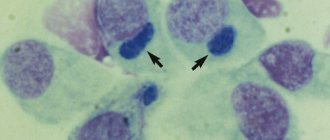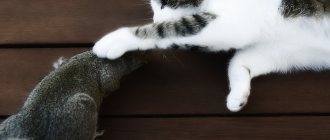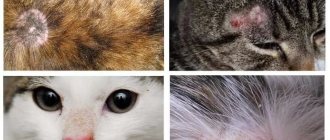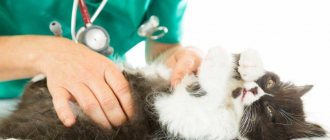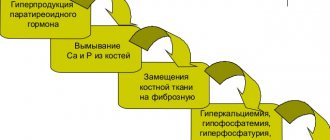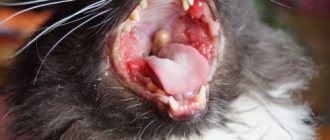Cats, like people, are susceptible to colds. But this disease in mustachioed pets is much more difficult. Colds in cats cause a lot of trouble for their owners. In our article we will talk about the symptoms of a cold, its consequences, prevention, methods of treatment, including at home.
Why does a cat get a cold?
A cold occurs in a cat as a result of hypothermia. During contact with cold, due to drafts, the pet’s immune system malfunctions. This creates the most favorable environment for the attack of viruses and microbes. In addition to hypothermia, there are other factors that contribute to the occurrence of colds, the most common among them:
- Weakening of the immune system due to previous diseases.
- Walking in the rain and wind.
- Finding an animal in drafts.
- Change of usual food.
- Unvaccinated animals with chronic diseases suffer from colds more often.
How can you tell if your cat has a cold?
When a cold occurs, it doesn't take long for symptoms to appear in cats. Before you start treating your pet, you need to be sure that it is a cold, because similar symptoms can occur with allergic and viral diseases. Only a veterinarian can accurately determine the disease. A cold in a cat usually manifests itself with the following symptoms:
- Hot and dry nose.
- Complete absence or loss of appetite.
- Lethargy, apathy.
- Runny nose.
- The cat sneezes.
- Cough.
- Hard breathing.
- Watery eyes.
- Fever.
If your cat has a cold and refuses to eat for more than 1.5 days, then you need to seek help from a veterinarian.
What complications can a cold cause?
A cold in a cat can cause dysfunction of some organs. If your pet is left untreated, a more severe condition may develop that affects organs such as the lungs, bronchi, kidneys, and joints. Because of this, the cat’s immunity weakens and its resistance to infectious diseases decreases. When the virus enters the body of a healthy animal, as a rule, nothing serious happens. If the virus affects a weakened pet, a pathological process may develop, for example, inflammation of the lungs, genitourinary system, bronchi, which will be much more difficult to cure.
What problems might you encounter?
Most often, cats suffer from thermal burns. To protect your pet from harm, you should think in advance about how to limit its access to heating appliances. Protect central heating radiators with special screens and isolate your cat from boiling water, hot oil and hot stove surfaces.
If the cat does get burned, take your pet in your arms, calm him down and carefully examine the burn area. Treat the affected area of skin with panthenol spray and try to bandage it. Do not allow your cat to lick the burned area and avoid contact of the affected skin with dirty surfaces. After treating a burn, contact your veterinarian immediately. If the burn is of a chemical nature, as a rule, you need to very carefully remove the remaining substance from the wound surface and under no circumstances allow it to be licked.
The second problem is poisoning. Cats can come across inedible and even life-threatening chemicals (for example, household chemicals). Even if the pet does not eat the harmful substances themselves, he can stain his fur with them and swallow them later, when “washing”. Symptoms of poisoning are obvious: apathy, lethargy, decreased temperature, repeated vomiting, diarrhea. If such symptoms are detected, the cat should be given a starvation diet, leaving only water. Try to give your pet some sorbent (for example, activated carbon) to drink and contact a veterinarian as soon as possible.
In addition, your pet may get hurt. If he gets injured while playing or hunting, don't panic. Take him in your arms and calm him down, examine the wound. If the wound is shallow and does not bleed much, treat it with a disinfectant solution (hydrogen peroxide, chlorhexidine), bandage it if possible and consult a veterinarian. But remember that you should not use iodine, brilliant green and other alcohol-containing solutions to treat wounds - they can cause a burn to the wound and aggravate the situation. If you find heavy bleeding, apply a tight bandage (for this it is most convenient to use self-fixing elastic bandages) and immediately take the cat to the veterinary clinic!
Most often, such injuries are the result of limbs being pinched by doors or owner inattention. However, sometimes they can also be a consequence of a fall from a height. If a cat received a fracture after falling from a small height, then in addition to treating the consequences of the fracture, the veterinarian may suspect a hormonal disease leading to brittle bones and suggest taking the necessary tests. If a cat falls from a significant height, even if at first glance everything is in order, you should definitely contact a veterinary clinic. Only in the clinic will it be possible to comprehensively assess the animal’s condition and prevent the consequences of the injury.
If you notice that your cat is limping or has been injured in your presence, do not try to apply a fixing bandage yourself - without proper anesthesia, you will only cause harm. If the injury is accompanied by damage to the skin, treat the wound as indicated above. After this, you should limit the animal’s mobility as much as possible, put it in a cage, pen or carrier and contact a veterinary clinic as soon as possible.
Some of the most dangerous are compressive injuries - for example, when cats get into window openings. The danger of such injuries is that with seemingly minimal external damage, hemodynamic disturbances and innervation of the pinched part of the body occur. Such a problem can cost the animal its limbs or even its life. Having discovered a cat in such a state, it is necessary to carefully and gradually release it from compression. And after release, contact a veterinary clinic as an emergency.
What to do at home?
If your cat's cold is mild, it can be treated at home. Before treating with medications, it is worth observing the animal and trying to relieve the symptoms of a cold. If there is no improvement within 24 hours, then you should urgently consult a veterinarian, he will prescribe antibiotics that will help cure the animal. If the cat’s condition stabilizes, then most likely he will cope on his own. The most common home remedies to help treat your pet are:
- If your cat has a cold, then first of all you need to give it rest.
- The pet needs a warm and dry room; under no circumstances should it be in a draft.
- A sick animal needs an increased drinking regime. You can give him warm milk.
- You can make warming compresses and heating pads; at this time, the cat’s blood flow increases, so it will warm up faster. In this case, recovery will take much less time.
- The nasal passages need to be cleared by cleansing measures. Why roll a cotton pad into a tube and clean your pet’s nose with it. If the cat does not have an allergic reaction, then instead of boiled water, you can use a decoction of chamomile, calendula or sage.
- If a cat has a cold and its nose is not breathing, then you can drip a few drops of eucalyptus onto the bedding on which the animal sleeps. This will make it easier for him to breathe.
- It is good to treat an animal with a massage; it has a warming effect.
- If your pet is sneezing and has a runny nose, you can blow pre-poured streptocide into his nostrils.
Treating cat colds with medications
If your cat's cold cannot be treated at home, then it must be treated with the help of a veterinarian. The clinic will examine the cat and prescribe the necessary medications. It is not recommended to use medications without a prescription from a specialist. Typically treatment includes:
- At high temperatures - antipyretics.
- For coughing and wheezing, use expectorants.
- Antibiotics.
- Immunostimulants help fight viruses.
- Vitamins.
- Antiviral serum.
It is impossible to treat a cat with human medications on your own; this can only worsen the pet’s condition; antibiotics are prescribed only if an infection occurs in the bronchi or lungs.
Antibiotics help treat severe colds or when there is a secondary infection. If a cat has a cold and refuses to eat or drink for a long time, the veterinarian will recommend giving it IV drips. Because dehydration is an extremely dangerous condition that can be fatal.
How can you wash a cat's nose?
If a kitten has a cold, treating its nose can significantly alleviate its condition. To do this, you can wash with the following preparations: 2% Zinc Sulfate, 3% Boric acid, a solution of Adrenaline with Novocaine, 0.5% Tannin. You can instill a mixture of 1% Methanol with fish oil.
General information
Causes of stress
The most common causes of stress in cats:
- Extraneous noises that the cat is not used to.
- Moving, change of scenery, renovation.
- A trip to the vet.
- Estrus, first motherhood or false pregnancy.
- Guests, strangers.
- The appearance of a new pet.
- Long absence of owners or their change.
- Lost favorite toy.
- Trying to walk with a harness for the first time as an adult.
- Diseases of internal organs that have not yet manifested themselves externally.
Manifestation of stress in cats
The first sign of stress in a cat is nervous behavior. The cat begins to actively lick itself without visible problems in a particular place, begins to meow and walk around the apartment with a worried look. The usual diet also changes - either the cat is attacked by gluttons and it eats stress, or, on the contrary, refuses to eat.
The second sign of a cat's anxiety is the desire to hide. Most often, cats hide when strangers appear in the house - it is easier for the animal to wait out the visit than to try to contact the stranger.
The third and most obvious sign of stress is aggression. The cat begins to hiss, bite, and reacts inadequately to simple and familiar manipulations. The tail begins to twitch constantly, the fur stands on end. All the “funny” videos from the Internet, where a cat is on tiptoe, arching its back somewhere on Friday - this is the most accurate demonstration of a cat’s severe simultaneous stress.
A panic attack is an extreme state of nervous tension in both humans and cats. It manifests itself by pressing the ears to the head, flowing saliva, involuntary urination and dilated pupils. The cat may begin to rush around the room or, on the contrary, crouch to the ground and not move.
In any case, before calming a cat at home, you need to understand how much stress the animal is experiencing, because nervous behavior and a panic attack can be caused by one factor, but obviously require different measures of influence.
Prevention
A cat may develop colds if it has a heat exchange disorder. In its normal state, a layer of air forms in its undercoat, something like a “thermos”, which reliably protects it from colds and prevents heat loss. When it gets wet, the “thermos” does not work, and the cat begins to freeze, at which time she becomes most vulnerable to drafts. If a cat comes home cold and wet after going outside, then the first thing to do is to provide him with warmth and quickly dry the animal.
The kitten must be protected during bathing, provided with the water temperature necessary for its body, and a warm towel. It must be remembered that the water temperature that is pleasant for bathing people will be low for cats. The most acceptable water temperature for bathing mustaches is 39-40 degrees. After bathing, the cat must be wrapped in a warm towel prepared in advance and pressed against your arms. This way the pet will calm down and warm up better.
If your cat gets a cold during a walk and does not recover with home remedies, then you need to contact a veterinarian as soon as possible. It will help cure a sick animal.
Causes of itching
Owners do not always immediately begin to sound the alarm when they discover scratching on their pet. Often they believe that this is not a very serious problem. If the scratching is minor and the itching does not particularly bother the cat, the owner can completely ignore this problem. But it is worth remembering that many diseases are curable only in the first stages. Therefore, it is important to promptly find out the cause of itching and provide professional help to your pet.
Lichen
This is an extremely contagious fungal disease that is also dangerous for humans. It is easily transmitted from a sick animal to a healthy one through short bodily contact, or even through grooming items (combs, nail clippers). Without timely treatment, lichen in dogs, like in cats, can lead to serious consequences for the health of the animal.
You might be interested in: What causes red spots on a cat's tongue?
The main symptoms of lichen infection:
- The coat appears unhealthy. A large number of broken hairs.
- Small bald spots appear, which the cat actively scratches. They can be found primarily on the head, neck and paws.
- Hard crusts appear on bald spots.
- Lost fur grows back very slowly.
- Dandruff appears on the skin.
- In the final stages, purulent lesions form.
Skin parasites
Fleas are a very common parasite, especially among cats that have free access to the outdoors. Fleas are quite dangerous, because their bites lead to a decrease in the animal’s immunity. The cat becomes vulnerable to various bacteria and fungi. Flea bites cause severe itching, causing the animal to constantly scratch. Particularly sensitive cats may scratch their skin until it bleeds.
Your cat can also pick up ticks, lice and coccidia. However, the animal does not have to go outside for this. The owner may well bring some parasites with him on shoes and clothes.
The main symptoms of infection with skin parasites:
- deterioration in the appearance of fur;
- severe itching;
- anxiety;
- fleas and ticks can be seen visually if you look closely at the animal’s skin.
A tick bite can lead to quite serious consequences. At the same time, the animal’s temperature may rise, loss of appetite, and decreased activity.
It is best to consult a veterinarian to remove a tick. If the procedure is performed incorrectly, parts of the tick may remain in the animal's skin, which can cause a purulent abscess to form.
Allergy
An allergic reaction can occur completely unexpectedly in any cat. Most often, animals suffer from food allergies. It often manifests itself when changing the diet or adding new foods to it. Food allergies are the easiest to identify and therefore easy to combat.
But when diagnosing non-food allergies, problems can arise. In this case, it is not always possible to determine which allergen caused the body’s negative reaction.
An allergic reaction can be caused by:
- individual food products (often chicken and milk);
- pollen and plant parts;
- flea and tick bites;
- various chemical elements contained in cleaning products and perfumes;
- dust.
Otitis
Otitis of the external ear is a serious disease that can cause many problems for the animal. Infection of the ear canals leads to inflammation. The cat constantly shakes its head and scratches its face until it bleeds.
The main symptoms of otitis in a cat:
- redness of the ear;
- anxiety;
- the cat constantly shakes its head;
- the animal scratches its ears and muzzle;
- increased body temperature;
- In the absence of timely treatment, pus may begin to leak from the auricle.
Worms
Even completely domestic cats are not immune from infection with worms. Parasite eggs can enter the animal's body through raw meat, unwashed hands, clothing, and grass. Infection with helminths leads to decreased immunity and disruption of the body.
The main symptoms of helminth infection:
- Deterioration in the appearance of the coat, scratching.
- Defecation disorder.
- The animal quickly loses weight.
- Itching in the area of the anus, which causes the animal to rub it on the floor and carpets.
- Decline in activity or, conversely, excessive anxiety.
- In advanced cases, severe shortness of breath occurs.
Bacterial diseases
Bacteria and fungi are found in small quantities on the skin of any cat. Usually, they do not cause any problems to the animal. But if the animal gets sick, its immunity is reduced, and the body is weakened, fungi and bacteria begin to actively multiply, which often leads to severe itching and scratching.
You might be interested in: What causes bumps on cats noses?
At risk are cats that already suffer from diabetes, allergies, and hyperthyroidism. This problem often occurs in kittens.
One of the most common bacterial infections in cats is pyoderma . Its main symptoms:
- severe itching;
- peeling of the skin;
- Scabs form on the wounds;
- baldness of certain areas of the skin;
- formation of purulent abscesses.
Pyoderma is very dangerous for cats. When the first symptoms appear, you should immediately consult a doctor.
Stress
All animals experience stressful situations differently. For some, moving or even ordinary fear can lead to not entirely adequate reactions. Constant licking of the same places may indicate mental disorders of the animal.
Of course, such a diagnosis can only be made after all other possible causes of itching have been excluded during the diagnostic process. The main symptoms of mental disorders and stress:
- refusal to eat;
- a decrease in activity or, conversely, excessive excitability;
- the animal constantly scratches or licks one place.
Breeds in which this problem most often occurs: Burmese, Orientals, Abyssinian and Siamese cats.
Disruption of hormone production
Disruption of the endocrine system leads to the appearance of various symptoms, including itching and scratching. A number of diseases that cause disruption of hormone production:
- Diabetes.
- Cushing's syndrome.
- Thyroid dysfunction.
Main symptoms:
- Hair loss and bald patches.
- Dryness and flaking of the skin.
- Severe itching and scratching.


